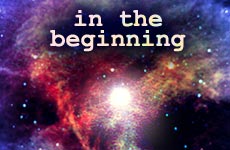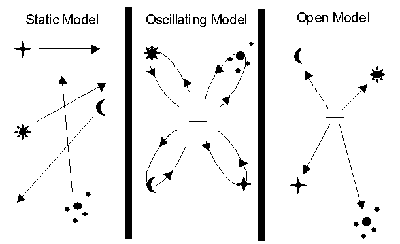What are the theological implications of modern cosmology?

Until the early twentieth century, astronomers entertained three possible models of the universe:
A) The universe could be static. It might be an infinite splash of stars and planets exhibiting no uniform motion. Even according to this theory, the mutual gravitational attractions of stars and planets might hold these astronomical objects together in the form of solar systems and galaxies. But each of these stellar/terrestrial groups would slide through space along its own random trajectory, unrelated to the courses tracked by other groups of stars and planets. The beauty of the static model is that it works for atheists and believers: Such a universe could have been created by God at some point in history, but it also could have existed forever without God.
(B) The universe could be oscillating. It might be a cosmic balloon alternately expanding and contracting. For a few billion years it would inflate into absolute nothingness. The gravitational attraction of every star and planet pulling on every other would eventually slow this expansion until the whole process would reverse and the balloon would come crashing back in upon itself. All that existed would eventually smash together at the universe’s center, releasing huge amounts of heat and light, spewing everything back out in all directions and beginning the expansion phase all over again. Such a universe could also have been created by God or could have existed forever without God.
(C) Or, finally, the universe could be open. It might be a cosmic balloon that never implodes. If the total gravitational attraction of all stars and planets could not halt the initial expansion, the universe would spill out into nothingness forever. Eventually the stars would burn out and a curtain of frozen darkness would enshroud all existence. Such a universe could never bring itself back to life. It would come into existence at a moment in history, blaze gloriously, and then pass into irrevocable night. Crucially, this model proposes that before the one-time explosion, all the universe’s matter and energy was contained in a singularity, a tiny dot that sat stable in space for eternity before it detonated. This model proposes a paradox: Objects at rest - like the initial singularity - remain at rest unless acted upon by an outside force; and yet, since the initial dot contained all matter and energy, nothing (at least, nothing natural) existed outside of this singularity that could have caused it to explode. The simplest resolution of the paradox is to posit that something supernatural kicked the universe into being. The open model of the universe thus implies a supernatural Creator.

In 1916 Albert Einstein released the first drafts of his Theory of General Relativity and the scientific world went wild. It appeared that Einstein had revealed the deepest secrets of the universe. His equations also caused a few problems—technical dilemmas, mathematical snags—but not the sort of thing of interest to newspapers or even popular science journals.
Two scientists noticed the glitches. Late in 1917 the Danish astronomer Willem de Sitter reviewed General Relativity and returned a detailed response to Einstein, outlining the problem and proposing a radical solution: General Relativity could work only if the entire universe was exploding, erupting out in all directions from a central point. Einstein never responded to de Sitter’s critique. Then, in 1922, Soviet mathematician Alexander Friedmann independently derived de Sitter’s solution. If Einstein was right, Friedmann predicted, the universe must be expanding in all directions at high speed.
Meanwhile, across the sea, American astronomer Vesto Slipher actually witnessed the universe’s explosive outward movement. Using the powerful telescope at Lowell Observatory in Flagstaff, Arizona, Slipher discovered that dozens of galaxies were indeed rocketing away from a central point.
At the end of World War I, de Sitter, Friedman and Slipher independently shared their findings with Einstein, but he strangely resisted their solution - as if, in his brilliance, he realized the theological implications of an exploding universe. Einstein even wrote a letter to Zeitschrift fur Physik, a prestigious technical journal, calling Friedmann’s suggestions “suspicious;” and to de Sitter Einstein jotted a note, “This circumstance [of an expanding universe] irritates me.” In another note, Einstein reassured one of his colleagues, “I have not yet fallen in the hands of priests”—a veiled reference to de Sitter, Friedmann and Slipher.
In 1925, the American astronomer Edwin Hubble, dealt the static model of the universe a fatal blow. Using what was then the largest telescope in the world, Hubble revealed that every galaxy within 6 x 1017 miles of the Earth was receding. Einstein tenaciously refused to acknowledge Hubble’s work. The German genius continued teaching the static model for five more years, until, at Hubble’s request, he traveled from Berlin to Pasadena to personally examine the evidence. At the trip’s conclusion, Einstein reluctantly admitted, “New observations by Hubble… make it appear likely that the general structure of the universe is not static.” Einstein died in 1955, swayed but still not fully convinced that the universe was expanding.
< Big ?the history: in explosion biggest the of echo discovered had they realized scientists two />
Ten years later, in 1965, Arno Penzias and Robert Wilson were calibrating a super-sensitive microwave detector at Bell Telephone Laboratories in New Jersey. No matter where the two scientists aimed the instrument, it picked up the same unidentified background noise—a steady, three-degree Kelvin (“3K”) hum. On a hunch, the two Bell Labs employees looked over an essay on General Relativity by a student of Alexander Friedmann. The essay predicted that the remnants of the universe’s most recent explosion should be detectable in the form of weak microwave radiation, “around 5K, or thereabouts.” The two scientists realized they had discovered the echo of the biggest explosion in history: “the Big Bang.” For this discovery, Penzias and Wilson received the Nobel Prize.
The discovery of the “3K hum” undermined the static model of the universe. There were only two models left: one worked without God and one did not. The last issue to be settled was: Had the primordial universe exploded an infinite number of times (the oscillating model)? Or only once (the open model)? Researchers knew that the issue could be settled by determining the average density of the universe. If the universe contained the equivalent of about one Hydrogen atom per ten cubic feet of space, then the gravitational attraction among all the universe’s particles would be strong enough to stop and reverse the expansion. Eventually there would be a “Big Crunch” which would lead to another Big Bang (and then another Big Crunch, etc.). If, on the other hand, the universe contained less than this density, then the Big Bang’s explosive force would overcome all the gravitational pulls, and everything would sail out into nothingness forever.
Curiously, the death of the static model inspired panic in many quarters of the scientific world. Mathematicians, physicists, and astronomers joined forces to prove the eternity of the universe. Dr. Robert Jastrow, arguably the greatest astrophysicist of the time and director of the National Aeronautics and Space Administration’s Goddard Center for Space Studies, was named head of the research project. For fifteen years Jastrow and his team tried to demonstrate the validity of the oscillating model, but the data told a different story. In 1978 Jastrow released NASA’s definitive report, shocking the public with his announcement that the open model was probably correct. On June 25 of that year, Jastrow released his findings to the New York Times Magazine:
“This is an exceedingly strange development, unexpected by all but the theologians. They have always accepted the word of the Bible: In the beginning God created heaven and earth… [But] for the scientist who has lived by his faith in the power of reason, the story ends like a bad dream. He has scaled the mountains of ignorance; he is about to conquer the highest peak; [and] as he pulls himself over the final rock, he is greeted by a band of theologians who have been sitting there for centuries.”
Dr. James Trefil, a physicist at the University of Virginia, independently confirmed Jastrow’s discovery in 1983. Drs. John Barrow (an astronomer at the University of Sussex) and Frank Tipler (a mathematician and physicist at Tulane University) published similar results in 1986. At the 1990 meeting of the American Astronomical Society, Professor John Mather of Columbia University, an astrophysicist who also serves on the staff of NASA’s Goddard Center, presented “the most dramatic support ever” for an open universe. According to the Boston Globe reporter covering the conference, Mather’s keynote address was greeted with thunderous applause, which led the meeting’s chairman, Dr. Geoffrey Burbridge, to comment: “It seems clear that the audience is in favor of the book of Genesis - at least the first verse or so, which seems to have been confirmed.” In 1998, Drs. Ruth Daly, Erick Guerra and Lin Wan of Princeton University announced to the American Astronomical Society, “We can state with 97.5 percent confidence that the universe will continue to expand forever.” Later that year, Dr. Allan Sandage, a world-renowned astrophysicist on the staff of the Carnegie Institution of Washington, was quoted in The New Republic saying, “The Big Bang is best understood as a miracle triggered by some kind of transcendent power.” Newsweek columnist George Will began his November 9, 1998 column with this quip: “Soon the American Civil Liberties Union, or People for the American Way, or some similar faction of litigious secularism will file suit against NASA, charging that the Hubble Space Telescope unconstitutionally gives comfort to the religiously inclined.” The same year, Newsweek reported a recent and unexpected swing of opinion among the once passionately agnostic: “Forty percent of American scientists now believe in a personal God—not merely an ineffable power and presence in the world, but a deity to whom they can pray.”
There are, of course, mathematicians, physicists, astronomers, and cosmologists who choose not to believe in God today. For a variety of reasons, they choose instead to have faith that new natural laws will be discovered or that new evidence will appear and overturn the current model of an open, created universe. But for many in the scientific community, the evidence is persuasive. For many, modern cosmology offers permission to believe.
by Rabbi Lawrence Kelemen
Posted in: Jewish Beliefs & Philosophy



